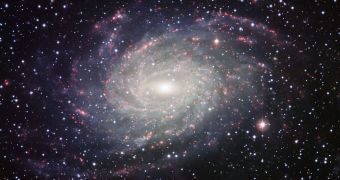Using the MPG/ESO 2.2-meter telescope, astronomers were recently able to capture a new image of the impressive spiral galaxy NGC 6744, which lies relatively nearby. The object can be found about 30 million light-years, in the southern constellation of Pavo (The Peacock).
A team of astronomers from the European Southern Observatory (ESO) used the organization's Wide Field Imager (WFI) instrument in order to capture the delicate intricacies. The reason why experts took so much care when they imaged this galaxy is because it looks just like our own.
NGC 6744 and the Milky Way are part of the same class of galaxies, and look very much like each other when viewed from far away. Experts could determine that because they are able to look at the nearby galaxy face on,
“Striking spiral arms wrapping around a dense, elongated nucleus and a dusty disc” are just some of the traits the two galaxies share, experts at ESO say in a press release. “There is even a distorted companion galaxy,” they add.
The Milky Way has at least two dwarf galaxies orbiting it, called the Small and Large Magellanic Clouds, respectively. The companion galaxy around the Milky Way analog is known as NGC 6744A,
“One difference between NGC 6744 and the Milky Way is their size. While our galaxy is roughly 100,000 light-years across, the galaxy pictured here extends to almost twice this diameter,” the astronomers explain.
“Nevertheless, NGC 6744 gives us a tantalizing sense of how a distant observer might see our own galactic home. This dramatic object is one of the largest and nearest spiral galaxies,” they add.
According to previous measurements of the galaxy, the structure has the apparent brightness of about 60 billion Suns. Even if that may be construed as fairly limited for a galaxy its size, the light it emits covers an area of the sky 66 percent the size of the full Moon.
The red dots seen in this image are in fact stellar nurseries, areas of intense stellar formation where numerous new stars are collapsing from massive dust clouds. But these regions also help beautify the galaxy, giving it a wonderful, spiraled appearance.
“The picture was created from exposures taken through four different filters that passed blue, yellow-green and red light and the glow coming from hydrogen gas. These are shown in this picture as blue, green, orange and red, respectively,” ESO concludes.

 14 DAY TRIAL //
14 DAY TRIAL //